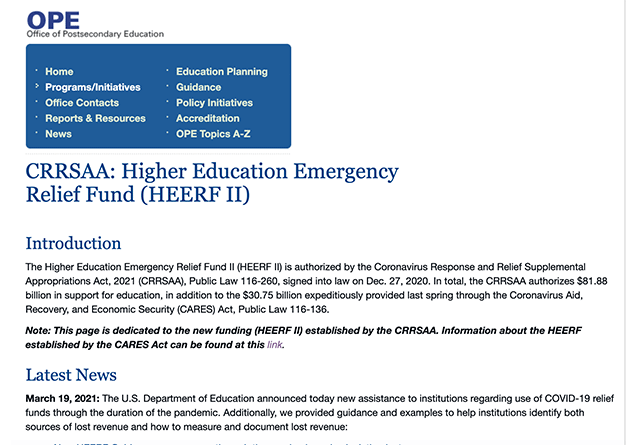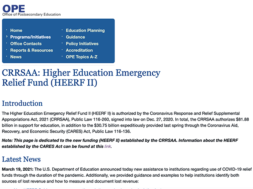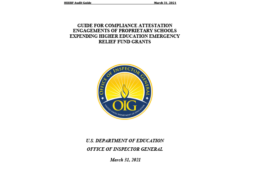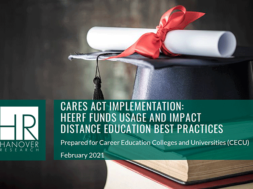
Summarizing HEERF2 Application and Implementation Provisions
By Michael T. Wherry, CPA, McClintock & Associates
If you’re getting a sense of déjà vu, you’re probably not alone, as more coronavirus relief programs with some familiar names are top of mind for higher education institutions. That does not, however, mean the provisions behind the programs will remain the same.
On Jan. 14, 2021, the U.S. Department of Education (ED) released instructions to access and key provisions to utilize the new round of the Higher Education Emergency Relief Fund, which was included in the recently passed Coronavirus Response and Relief Supplemental Appropriations Act (CRRSAA). This round will be referred to as HEERF2 to differentiate it from the HEERF grants distributed through the CARES Act (HEERF1). McClintock & Associates (M&A’s) previous article on the CRRSAA can be found here With this new guidance ED, has provided the funding allocation tables, instructions to apply for the grant, some guidance on utilization of the grants, and necessary compliance requirements. All of the information ED has released can be found here.
This summary focuses on key provisions related to the utilization and compliance related to the grants, along with M&A’s commentary in italics.
ED released Frequently Asked Questions documents, spelling out a number of provisions, located here. M&A reminds institutions that this article is meant to be for general information and not to be relied upon for legal or regulatory advice. Each institution’s specific circumstances are imperative to understand in making any decision regarding utilization of the HEERF1 and HEERF2 grants. We recommend that institutions ensure their regulatory counsel and auditors are both in agreement regarding how the grant funds are claimed, especially in regard to HEERF1 institutional grants utilized under the HEERF2 expanded uses, as noted in the subsequent text.
General
- The financial aid grants provided to students must be prioritized to students with exceptional need, such as students who receive Pell grants. However, students do not need to be only Pell recipients or students who are eligible for Pell grants. Our thought of a one-size-fits-all award for eligible students may not meet the intent of the regulations nor would awarding a set amount to all students.
- Institutions can consider other factors to define exceptional need (e.g., on-campus housing, dependent students whose parents refuse to take out a PLUS loan, professional judgements for changes in employment/income, Pell recipients which didn’t receive SEOG or similar institutional noncash scholarship)
- The CRRSAA explicitly provides that financial aid grants to students may be provided to students exclusively enrolled in distance education.
- ED is allowing the student financial aid grant to be applied to tuition if the institution obtains the student’s written (or electronic) affirmative consent.
- Institutions should develop this consent document and consider having regulatory counsel review prior to implementation. A signed hard copy with a physical signature will meet the requirements. For electronic consent, we would recommend an email to the student with the document and the student’s email confirmation, typed signature on the document, or a scanned copy of a physical document. M&A is not sure a text message would be sufficient proof of consent.
- Any funds applied to a student’s account would be reportable on the annual 1098-T.
- Institutions are restricted from making financial aid grants conditional on a student’s continued or future enrollment, nor can it be conditional on the student to provide affirmative consent to resolve an outstanding account balance.
- Therefore, we recommend that institutions don’t have one grant with multiple disbursements. Instead, the institution should have separate specific grants if funds are to be used over time.
- Grants to students under the CRRSAA is not subject to ED’s June 17, 2020, Interim Final Rule (IFR) (85 FR 36494) which restricted eligibility to only students who are or could be eligible to participate in Title IV.
- Institutions may have an expanded base of students to which financial aid grants can be made using the CRRSAA funding. It appears that non-Title IV students and students enrolled in non-Title IV programs would be eligible.
- Uncertainty still exists about whether international or DACA students would be eligible. At this point in time, we have advised institutions not to include these students.
- ED reminded institutions of the cash management regulations under 2 CFR § 200.305(b) which includes the timing of the draw down of the funds, maintaining the funds in an interest-bearing account and remitting any interest in excess of $500 to the federal government.
- We recommend that institutions review these regulations and continue to draw down the funds, as they are expended, into a separate bank account. An institution may want to hold funds drawn down for student financial aid grants in the separate bank account for any uncashed student check.
- If an institution is adhering to the regulations noted, then any interest earnings should be well below $500 based upon current interest rates.
- Institutions could use the same bank account(s) as the HEERF1 grants.
- The CRRSAA guidance indicates that institutions must apply within 90 days for the grant. However, public or private institutions don’t need to reapply and, thus, some uncertainty exists.
- To be safe, institutions may want to apply, is required, and disburse a small portion of the grant by April 15, 2021.
CARES Act (a)(1) expanded uses
The expanded use of funds authority under the CRRSAA also applies to any unspent CARES Act (a)(1) program funds, including the student HEERF grant (CFDA 84.425E) and the institutional HEERF grant (CFDA 84.425F). Institutions may use those unexpended funds for the following reasons, which are effective as of Dec. 27, 2020. However, ED hasn’t provided any further guidance except what is included in the FAQ Rollup Document issued related to the CARES Act (located here). ED indicated that they are in the process of identifying and clarifying which specific Rollup FAQs may continue to be relied upon with the new CRRSAA and for an institution’s unexpended CARES Act funds. However, at the date of publishing, no further guidance has been released.
- Defraying expenses associated with coronavirus (including lost revenue, reimbursement for expenses already incurred, technology costs associated with a transition to distance education, faculty and staff trainings, and payroll).
- The expanded definition specifically includes lost revenue and payroll but does not define them. Thus, questions remain. Is the lost revenue guidance under 18004(a)(2) and (3) applicable to follow for 18004(a)(1)? The following items would seem to be allowable lost revenue and M&A believes more specific guidance from ED would be beneficial. These are just M&A’s thoughts and considerations and are not included in any statute or ED guidance. From M&A’s discussion with an ED official, the HEERF1 unused institutional funds are not bound by the Dec. 27, 2020, date for the expanded uses allowed under CRRSAA. However, NASFAA released guidance on March 2, 2021, that implies the unexpended HEERF1 grants are subject to the Dec. 27, 2020, date. Thus, significant uncertainty exists on this crucial definition.
- New and incremental payroll costs certainly seem to be allowable under HEERF2 or under HEERF1 due to the expanded definitions. Reminder, that any payroll claimed under the Paycheck Protection Program loans should not be claimed under either HEERF1 or HEERF2.
- Temporarily closed clinic (e.g., cosmetology) – Basis would be a monthly average based upon a 12-month period of time of the applicable month for the past two to three years.
- Decrease in enrollment due to social distancing requirements – Based upon the number of students being limited due to state or local ordinances.
- Closures of cafeteria and housing – Basis would be a monthly average based upon a 12-month period of time of the applicable month for the past two to three years. (M&A would ensure that lost revenue isn’t claimed for any period in which CARES Act funds were used to cover housing and meal refunds).
- Implementation of new programs which were delayed in starting due to accrediting body visits – Claiming an estimate of revenue had the new program started on time could be difficult to link to the pandemic but if additional rent was incurred specifically for this new program which was delayed, then claiming the additional rent seems reasonable.
- The ED official to whom M&A spoke reinforced the position that lost revenue should not be claimed for a general or overall decrease in revenue. The decrease in revenue needs to be tied specifically to the pandemic. For example, an overall decrease in revenue may be caused due to the pandemic but this can’t be known for certainty. However, the closure or limitations in clinic service revenue or dormitories due to state and local mandates appear to have a direct link to the pandemic.
- M&A also believes that a school should not claim rent expense and lost revenue for the same reason.
- The expanded definition specifically includes lost revenue and payroll but does not define them. Thus, questions remain. Is the lost revenue guidance under 18004(a)(2) and (3) applicable to follow for 18004(a)(1)? The following items would seem to be allowable lost revenue and M&A believes more specific guidance from ED would be beneficial. These are just M&A’s thoughts and considerations and are not included in any statute or ED guidance. From M&A’s discussion with an ED official, the HEERF1 unused institutional funds are not bound by the Dec. 27, 2020, date for the expanded uses allowed under CRRSAA. However, NASFAA released guidance on March 2, 2021, that implies the unexpended HEERF1 grants are subject to the Dec. 27, 2020, date. Thus, significant uncertainty exists on this crucial definition.
- Carrying out student support activities authorized by the Higher Education Act of 1965, as amended (HEA) that address needs related to coronavirus; and
- Making financial aid grants to students including by providing such grants to students exclusively enrolled in distance education.
- Pursuant to section 314(d)(5), an institution that utilizes the expanded use of funds authority under the CRRSAA for its unspent CARES Act funds must ensure at least 50% of the funds it received under CARES Act section 18004(a)(1) (generally, its Student Aid Portion award) is used for financial aid grants to students.
- From discussions with our clients, most institutions have fully spent their student HEERF portion, so this requirement would be met. Institutions should be careful if a small amount of student HEERF grants are not spent, and they plan to utilize any remaining institutional HEERF grants under the expanded definition in the CRRSAA.
- The FAQ, number 8 provides a brief answer on possible uses for student support activities. The TRIO guidance for student support activities provides some possible considerations for institutions that have academic support programs to retain and graduate students who are low-income, first-generation and individuals with disabilities. The TRIO student support program costs can be utilized for students with limited English proficiencies and to improve financial/economic literacy. An institution needs to ensure that funds claimed are for “needs” related to the coronavirus. Establishes this link and connections is crucial.
Proprietary institution specific provisions
- A reminder that proprietary institutions are only receiving HEERF2 to be utilized for financial aid grants to students. No institutional HEERF2 grant exists and therefore no costs can be claimed for administering the HEERF2 grant student disbursements.
- These institutions must submit a certification and agreement (Red C&A) under the new funding opportunity (CFDA 84.425Q) via grants.gov. In addition, applications must be received within 90 days of the Notice Inviting Applications, which is April 15, 2021.
- Institutions should ensure the application is assigned to a specific employee so as not to overlook the timing. Recently, institutions were completing the annual HEERF grant reporting, IPEDS, closing the books for a December 31 fiscal year end and preparing for audits, and completing 1098-T.
- Proprietary institutions may receive a restriction on the CRRSAA section 314(a) award until the CARES Act HEERF reporting obligation is completed.
- The quarterly HEERF reporting must have been posted to an institution’s website by January 10, 2021, and the annual HEERF reporting requirement must have been completed by February 8, 2021.
- Recipient must, to the greatest extent practicable, continue to pay its employees and contractors during the period of any disruptions or closures related to coronavirus pursuant to section 315 of the CRRSAA.
- This is similar to the CARES Act and no further guidance is provided by ED. As noted earlier, the expanded uses of the CRRSAA indicates payroll, and we hope that ED provides a linkage between maintaining employees and appropriate use of the HEERF grants in regard to payroll.
- A new requirement was added that a proprietary institution must have a compliance audit conducted of its administration of the HEERF grant(s) for any institutional fiscal year during which: (1) the institution expended $500,000 or more in total HEERF grant funds, whether under section 18004(a)(1) of the CARES Act or section 314(a)(4) of the CRRSAA, or (2) was on Federal Student Aid’s Heightened Cash Monitoring (HCM) 1 or 2 list during any point of the institution’s fiscal year in which it expended any HEERF grant funds. This HEERF Audit Guide will be developed by the Office of Inspector General.
- This provision was added solely for proprietary institutions as the HEERF grants are specifically included in the Compliance Supplement Addendum 2020, which governs nonprofit institutions receiving federal funding. We anticipate the HEERF Audit Guide to be consistent with the Compliance Supplement Addendum 2020.
- Currently, we believe auditors should be auditing the HEERF grants as part of the financial statement audit, as these audits are subject to Government Auditing Standards but are specifically identified as not being part of the Title IV program. However, the threshold to report a finding is limited to an error which would lead to a material misstatement in the financial statements, which is a much higher threshold than what we anticipate will exist in the HEERF Audit Guide. While we anticipate that we can leverage some of the work performed in the financial statement audit, it is likely additional time will be incurred to perform all steps required by the HEERF Audit Guide and draft an audit report for submission to ED. The timing of the HEERF grant audit submission to ED is unknown.
- ED indicated that the annual student financial aid compliance audit (FSA Audit) can be used to cover the HEERF audit if separately auditing would be duplicative. In our opinion, since the HEERF grants are not Title IV funds and are tied more closely to the financial statement audit, we don’t plan to audit as part of the FSA Audit.
- In the Red C&A, Question 7, ED indicates that the Secretary does not consider these individual financial aid grants to constitute Federal financial aid under Title IV of the HEA. Question 11 in the HEERF Rollup FAQ specifically notes that the funds received under the CARES Act in 18004(a)(1) paid to an institution are not included in revenue for 90/10 purposes.
- Since no new institutional HEERF2 grants will be provided to proprietary institutions, no change to this guidance is expected.
- The question which arises is the usage of the student HEERF2 grants which can be applied to tuition. Utilizing HEERF2 grants to apply or utilizing unused institutional HEERF grant under the expanded CRRSAA guidance for tuition (assuming student consent is received as described earlier) raises the question as to the proper treatment in the 90/10 calculation. As noted, ED has indicated these funds are not Title IV funds and M&A would concur. Therefore, these funds would not be included in the numerator of the 90/10. However, grants utilized to pay for tuition is a cash basis transaction and would seem to be included in the 90/10 denominator similar to Veterans Administration funding. These are federal funds and would not meet the Presumption Rule categories but would nevertheless be a cash payment for institutional charges.
- However, as this article goes to press, Section 2013 of the American Rescue Plan Act of 2021 would change this treatment to require HEERF grants to be included in the numerator along with including other federal funding. Uncertainty exists if this would be all HEERF grants or just the portion applied to tuition. Institutions need to closely monitor this legislation and the impact on the 90/10 calculation.
- Given the Congressional legislation related to the 90/10 calculation, we advise an institution to discuss the treatment of these funds in their 90/10 calculation with regulatory counsel and their auditor prior to any draw downs and disbursements.
As they have over the past year, institutions must educate themselves on the provisions behind the new law and its programs. McClintock & Associates will remain an open resource for those with questions and concerns. Reach out to our experts here.
MICHAEL WHERRY is a Certified Public Accountant who has 25 years of experience providing a full range of client service and consulting services in the public sector to postsecondary schools which include financial statement audits, Title IV compliance audits, agreed-upon-procedure attestation engagements for regulatory requirements, 90/10 calculation reviews, composite score projections and planning, financial statement reporting, consulting and understanding of new accounting requirements, transaction services for buyer/sellers, internal control processes and procedures, and coordination with Tax Department on tax savings and opportunities. He has presented at regional and national industry conferences in regard to regulatory and audit issues affecting postsecondary institutions.
Prior to joining McClintock & Associates in 1991, Mr. Wherry worked for Deloitte. In addition to his professional responsibilities, Mr. Wherry is the treasurer of the East Liberty Family Health Care Center in the city of Pittsburgh and has earned the honor of Eagle Scout. He resides in Pittsburgh, Pa. with his wife and two sons.
Contact Information: Michael Wherry // CPA // McClintock & Associates // mwherry@mcclintockcpa.com // https://www.mcclintockcpa.com //https://www.linkedin.com/in/mike-wherry-a542259/




